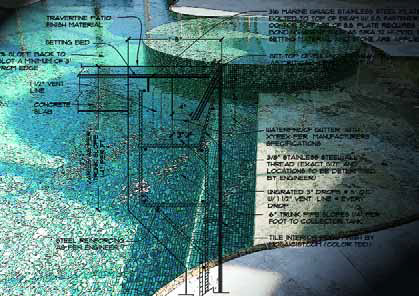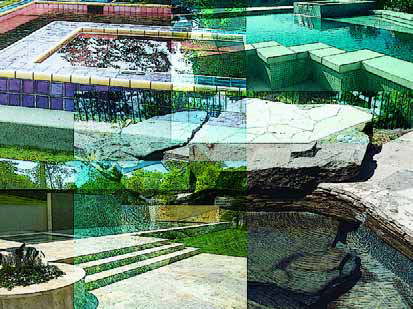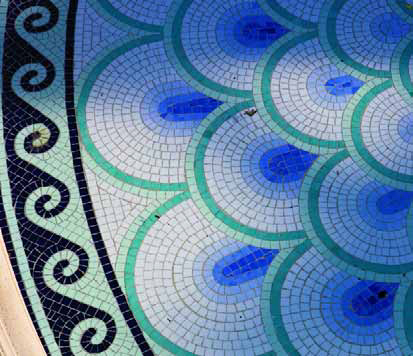Pools & Spas
With every new project, we always strive to create unique watershapes that reflect particular clients’ wants, needs, dreams and imaginations. What this means, given the fact that every client is an individual, is that no two of our pools are ever quite the same. In the case described in this article, for example, the clients’ distinctive personalities led us to create something that’s more like a waterpark than a residential pool/spa combination. In a very real sense, it reflects their personalities and a sense of the magic they find in certain chapters of our history – a special space for them to enjoy with their children. The clients purchased the newly built home on a hill overlooking the ocean in
It’s true for any watershaper: No matter how varied the work you do, it never hurts to be known for the ability to do something special – and for doing it exceptionally well. Through the years, for example, my firm has polished its ability to provide our clients with watershapes reflecting a wide variety of tastes, styles and features, but to an extent that sometimes surprises even me, we’re known among prospective clients for
It all started in 2002, when I was contacted by an architect who’d been retained to design a recreational complex for a huge estate in a wealthy Chicago suburb. I knew at the time that this would be big, but in those early days I had no clear idea exactly what it would ultimately entail. It’s a familiar story: Before the call came in, the homeowner had spoken with a number of pool-contracting firms in the area and had visited a number of projects that failed to impress her. The unusual thing is, at the time she called I was focused exclusively on pursuing large-scale commercial projects and waterparks and didn’t see anything even approaching a
For the past year and more, we’ve worked our way step by step through the many processes involved in designing and installing quality residential watershapes, starting from the first contact with a prospective client and working our way through, in the last two months, to the application of well-selected interior finishes. A concern I’ve always had with this step-wise approach is that it makes too many of these operations seem as though they happen in isolation and that decisions about design and materials and finishing touches are made as
Although the concept is relatively unfamiliar in the United States and largely untested here, pools supported by an entirely natural approach to filtration and water management have been under development in Europe for decades and have caught on there in a big way in recent years. In this special feature, German watershaper and natural-pool expert Rainer Grafinger discusses the ‘technology’ behind this potent European trend. For most people in the United States, swimming is far from a natural experience: Bathers move back and forth in man-made, chemically treated backyard or public swimming pools and seldom (if ever) find themselves in
It seems odd to say it, but I first became involved with this project largely because I happen to live on the same street as my clients. We all live in a beautiful, historic neighborhood in Mountain Lake, N.J., a small town that lays claim to having the largest collection of authentic Craftsman-style homes of any municipality in the United States. It’s the kind of place where residents take immense pride in the architectural splendors you see almost everywhere you turn. Most of these homes were designed and built by the legendary architect and builder
Last month, I entered into a discussion of the emergence of a whole range of beautiful finish materials that have helped (in my humble opinion) turn watershaping into an art form. My focus there was on glass and ceramic tile; this time, I want to turn the same sort of attention to plaster and exposed aggregates – huge additional factors in the industry’s ongoing creative momentum. Before I begin, let me draw an important distinction: The artistry in watershaping is not so much based on the types of materials we choose or how special or costly they might be; instead, it has everything to do with
Not long ago, I was asked by a reporter from The New York Times to define the main difference between swimming pools now compared to what they were 20 years ago. As we talked, it became clear that she was mostly thinking about technological breakthroughs in pumps and chemical treatments and the like. I confirmed for her that, yes, those products had come a long way. But I wouldn't let her stop there, suggesting that there was much more than a run of technical advancements behind the explosion of interest in watershapes in the recent decades. What we've also been seeing, I said, is a latter-day Renaissance of interest in classical notions of
Not long ago, I was asked by a reporter from The New York Times to define the main difference between swimming pools now compared to what they were 20 years ago. As we talked, it became clear that she was mostly thinking about technological breakthroughs in pumps and chemical treatments and the like. I confirmed for her that, yes, those products had come a long way. But I wouldn't let her stop there, suggesting that there was much more than a run of technical advancements behind the explosion of interest in watershapes in the recent decades. What we've also been seeing, I said, is a latter-day Renaissance of interest in classical notions of
Working on estate-sized residential projects is like assembling huge jigsaw puzzles in which all sorts of disparate pieces must ultimately fit together. While many of the individual parts have their own character and entail particular design and construction challenges, they're all part of a big picture you need to hold firmly in mind through every project phase. At GCS of Woodbridge, Calif., we pride ourselves on operating on a grand scale and on delivering the whole package, from landscape, hardscape, irrigation, control, communications, lighting and sound systems to watershapes of all sizes and types. Keeping all those elements sorted out within a single operation means we need to





















